人教版高中英语必修二unit-1-词汇课教案
- 格式:doc
- 大小:32.00 KB
- 文档页数:2

Cultural Relics--In Search of the Amber Room (阅读课)教学内容:人教版高中英语必修2 Unit 1课题名称: Cultural Relics--In Search of the Amber Room (阅读课)一、教学指导思想充分调动学生的积极性,使学生自主学习,让学生成为问题的"发现者",然后学生与学生进行合作性的探究,让老师成为问题的"点拨者"。
当然,在整个教学过程中,教师也是学生学习的合作者、引导者和参与者,形成师生互动,但教师要"少动",学生要"多动",多给学生自由发展的平台。
二、学生分析1、教学对象为高中一年级学生,智力发展趋于成熟。
他们的认知能力比初中阶段有了进一步的发展,渐渐形成用英语获取信息、处理信息、分析问题和解决问题的能力,因此我特别注重提高学生用英语进行思维和表达的能力。
通过任务型课堂活动和学习,学生的学习自主性得到加强,不再认为英语的课堂学习很枯燥,主动参与到活动中去,成为课堂的主体,同时也加强了与他人交流合作的能力。
2、学生已经完成了高中英语第一个模块的学习,渐渐习惯了我的教法。
不过,本班学生的水平参差不齐,有些差距还相当大。
因此在教学过程中,布置的任务要兼顾各个层次的学生,使他们都有所收获。
三、教材分析本单元以Cultural Relics为话题,旨在通过单元教学使学生了解世界文化遗产,学会描述它们的起源、发展和保护等方面的情况,复习并掌握定语从句,能在英语口语交际过程中判断别人给出的依据,并给出自己的观点,能回信并就如何保护和处理世界文化遗产给出自己的观点。
这一课是本单元第一个课时。
在上这一节课前并没有让他们了解太多的与课文内容相关的知识,只由于这课出现的人名和地方名比较多,我在课前教他们读了一下。
我在备这一课时,发现它的 Warming-up 部分会花费比较长的时间,于是我没有采用,而使用了我自己另外准备的引入(只是花了 4 到 5 分钟的时间),让学生对这课的话题作好心理准备,也为了完成本单元的目标作了铺垫。
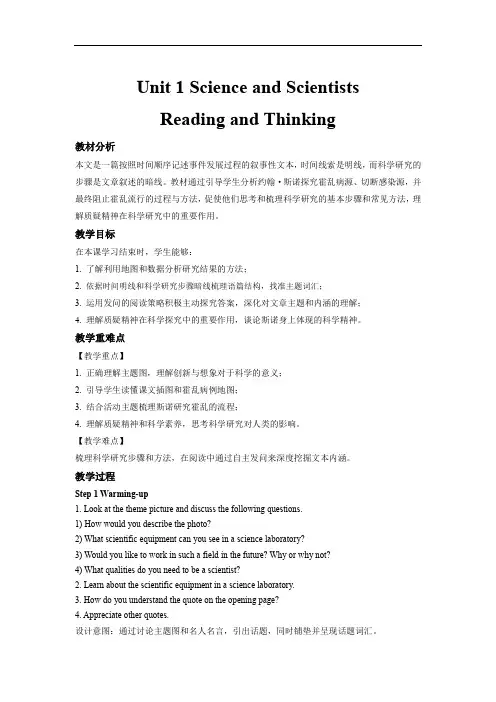
Unit 1 Science and ScientistsReading and Thinking教材分析本文是一篇按照时间顺序记述事件发展过程的叙事性文本,时间线索是明线,而科学研究的步骤是文章叙述的暗线。
教材通过引导学生分析约翰·斯诺探究霍乱病源、切断感染源,并最终阻止霍乱流行的过程与方法,促使他们思考和梳理科学研究的基本步骤和常见方法,理解质疑精神在科学研究中的重要作用。
教学目标在本课学习结束时,学生能够:1. 了解利用地图和数据分析研究结果的方法;2. 依据时间明线和科学研究步骤暗线梳理语篇结构,找准主题词汇;3.运用发问的阅读策略积极主动探究答案,深化对文章主题和内涵的理解;4. 理解质疑精神在科学探究中的重要作用,谈论斯诺身上体现的科学精神。
教学重难点【教学重点】1. 正确理解主题图,理解创新与想象对于科学的意义;2. 引导学生读懂课文插图和霍乱病例地图;3. 结合活动主题梳理斯诺研究霍乱的流程;4. 理解质疑精神和科学素养,思考科学研究对人类的影响。
【教学难点】梳理科学研究步骤和方法,在阅读中通过自主发问来深度挖掘文本内涵。
教学过程Step 1 Warming-up1. Look at the theme picture and discuss the following questions.1) How would you describe the photo?2) What scientific equipment can you see in a science laboratory?3) Would you like to work in such a field in the future? Why or why not?4) What qualities do you need to be a scientist?2. Learn about the scientific equipment in a science laboratory.3. How do you understand the quote on the opening page?4. Appreciate other quotes.设计意图:通过讨论主题图和名人名言,引出话题,同时铺垫并呈现话题词汇。
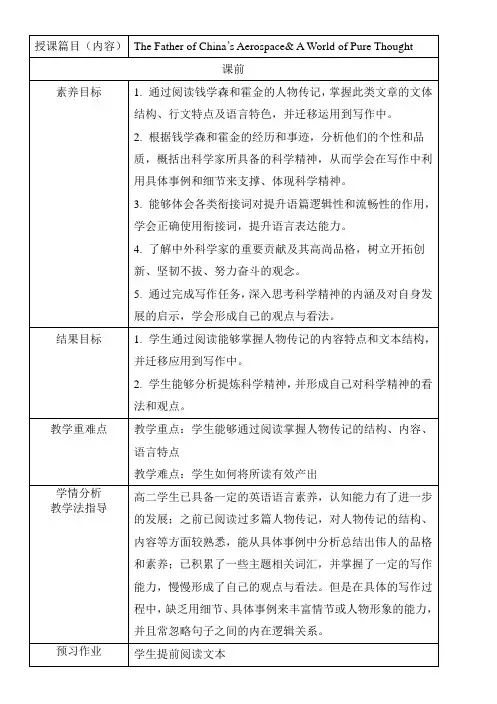
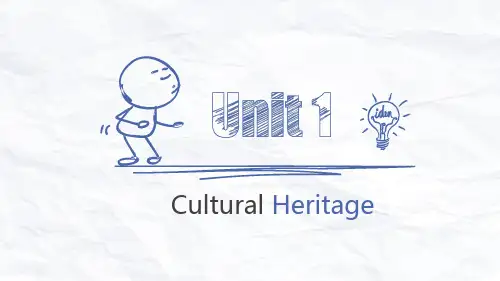
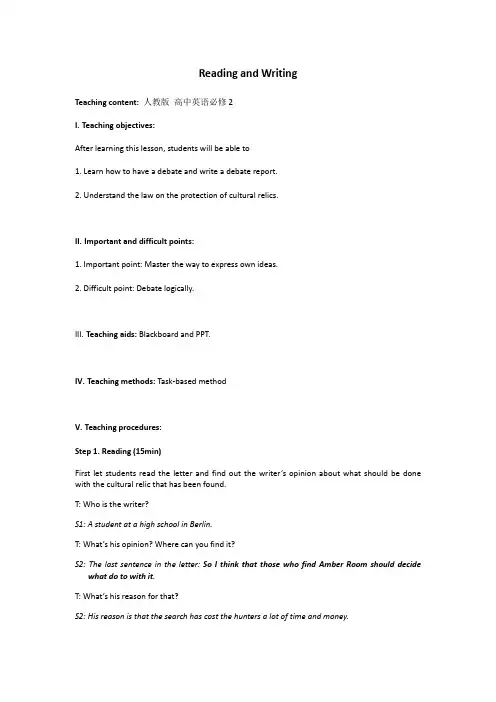
Reading and WritingTeaching content: 人教版高中英语必修2I.Teaching objectives:After learning this lesson, students will be able to1. Learn how to have a debate and write a debate report.2. Understand the law on the protection of cultural relics.II.Important and difficult points:1. Important point: Master the way to express own ideas.2. Difficult point: Debate logically.III.Teaching aids: Blackboard and PPT.IV.Teaching methods: Task-based methodV.Teaching procedures:Step 1. Reading (15min)First let students read the letter and find out the writer’s opinion about what should be done with the cultural relic that has been found.T: Who is the writer?S1: A student at a high school in Berlin.T: What’s his opinion? Where can you find it?S2: The last sentence in the letter: So I think that those who find Amber Room should decide what do to with it.T: What’s his reason for that?S2: His reason is that the search has cost the hunters a lot of time and money.T: By the way, what does “think highly of” in the first line mean?S3: It means to admire or respect someone or something.think highly / much / well of…=sing high praise for…think little / nothing of…e.g.The headmaster thought highly of me for my good performance.e.g.The little boy was well thought of by them.He thought nothing of walking 40 miles.走40英里, 他不当回事。
![[高中英语]高考英语(人教版)复习教学案:必修2 Unit 1 Culturalrelics](https://uimg.taocdn.com/2f63787ef8c75fbfc67db20a.webp)
必修2Units 1~2二、关于养狗的民意调查Step Ⅰ请你根据上表, 用英语写一篇文章客观反映民意调查结果, 并简单谈谈自己的看法成或者反对养狗的理由.注意:词数100左右;开头已为你写好内容必须包括所有要点, 可以根据内容合理发以使行文连贯.基础梳理整合词汇拓展1.____________ adj.珍贵的;有价值的→____________ n.价值2.____________ v i.幸免;幸存;生还→____________n.生还者→____________n.幸存;生还3.____________ v t.使吃惊;吃惊→____________ adj.令人吃惊的→____________ n.吃惊4.____________ v t.挑选;选择→____________ n.挑选;选择5.____________ n.设计;图案;构思→____________ n.设计师;制图员6.____________ adj.奇特的;异样的→____________ v t.想象;设想;爱好7.____________ v.装饰;装修→____________ n.装饰8.____________ n.珠宝;宝石→____________ n.珠宝;首饰(总称)9.____________ n.艺术家→____________ n.艺术10.____________ v i.属于;为……的一员11.____________ n.接待;招待会;接收→____________ v.接收;收到12.____________ adj.木制的→____________ n.木头13.____________ n.怀疑;疑惑→____________ v t.怀疑;不信14.____________ prep.值得的;相当于……的价值→____________ n.价值;作用→____________ adj.有价值的;值得……的15.____________ n.绘画;画→____________ v.绘画;画16.____________ n.根据;证据→____________ adj.明白的;明显的17.____________ v i.爆炸→____________ n.爆炸18.____________ n.入口→____________ v.进入19.____________ n.水手;海员;船员→____________ v.航海;航行20.____________ adj.非正式的→____________adj.正式的21.____________ n.争论;辩论→____________ v i.争论;辩论语镜记词1.These fish are very ____________(稀有的)in this country.2.Of the 30 people in the plane that crashed,only one ____________ (幸存).3.John paid only 3,000 for this used car but it's ____________ (值) a lot more.4.Who has been ____________ (挑选)to take part in the match?5.We are sending you some money in return for your ____________(宝贵的)help.6.He is,without ____________(疑问),the cleverest student I've ever taught.7.I can't tell the twins ____________ (分别地).8.The basic ____________(设计) of the car is very similar to that of earlier models.9.We found further scientific ____________(证据) for this theory.10.The bomb was ____________(爆炸) by remote control.短语回顾1.____________search ____________ 寻找2.belong ____________ 属于3.____________ return 作为报答;回报4.____________ war 处于交战状态5.____________ than 少于6.take ____________ 拆开7.think ____________ ____________ 看重;器重;对……评价很高典句背诵1.____________ ____________ ____________ ____________ ____________ the boxes were then put on a train for K nigsberg,which was at that time a German city on the Baltic Sea.毫无疑问,这些箱子后来被装上了火车运往哥尼斯堡,当时德国在波罗的海边的一个城市.句型提炼:There is no doubt that...毫无疑问……2.____________ ____________ ____________ ____________ lost cultural relics such as the Amber Room or Y uanmingyuan in Beijing?重建琥珀屋或北京圆明园这样的文化古迹有价值吗?句型提炼:It is worth doing...值得做某事.归纳拓展1.design n.设计;图案;构思v t.设计;计划;构思(1)by design=on purpose 有意;故意have designs on/upon sth.(money/life) 图谋某物(钱、生命)(2)be designed for sb./sth.为某人/某物设计、计划be designed to do sth.为做某事计划、设计be designed as sth.作为……而设计①It happened—whether by accident or design—that the two of them were left alone after all the others had gone.碰巧——不知是偶然还是有意安排——其他人走后,只剩下了他们两个人.②The textbook is designed for the English beginners.这一教材是为英语初学者设计的.③This course is designed as an introduction to the subject.这门课程是作为该科目的入门课而开设的.反馈1.1We don't know it was done by chance or______.A.by accident B.for purpose C.on design D.by design反馈1.2(2013·湖北荆州质检)Through the years,Special English has become a very popular tool for teaching English,even though it was not ______as teaching program.A.attached B.designed C.performed D.appealed2.doubt n.怀疑;疑惑v t.疑惑;不信There is no doubt at all that we did the right thing.毫无疑问我们做得对.用法拓展(1)doubt 用作动词,后接名词、代词或宾语从句.在否定句或疑问句中,doubt后常接that引导的宾语从句;在肯定句中,doubt后面常接whether或if引导的宾语从句.(2)doubt用作名词,常与about/of等介词连用,其后也可接同位语从句.doubt用在否定句中,后面接that引导的同位语从句;用于肯定句中,后面接whether引导的同位语从句.注意此时,不可以用if替换whether.(3)in doubt 怀疑;拿不定主意no/without/beyond doubt无疑地;必定;当然There is no doubt about .../that ...毫无疑问……(4)doubtful adj.怀疑的①I never doubted that she would come.我从未怀疑过她会来.②You can complain,but I doubt if/whether it will make any difference.你可以抱怨,但我怀疑是否起作用.③The meeting has been,without doubt,one of the most useful meetings we have had so far.无疑这是我们迄今为止最有用的会议之一.反馈 2.1(2013·东北三省第一次大联考)There's no doubt ______ 2013 will bring more changes when the world economy is still unclear.A.what B.that C.how D.where反馈2.2What the doctors really doubt is______ my mother will recover from the serious disease soon.A.when B.if C.whether D.what反馈2.3We don't doubt ______ he can do a good job of it.A.that B.if C.what D.whether反馈2.4Don't ______ to give me a call in case you are in trouble one day.A.delay B.hesitate C.doubt D.desire3.survive v t.比……活得长;(经过……)活(保存)下来v i.活下来;幸存;残留survive sth.在……之后仍然生存;从……之中逃生survive sb.(by ...) 比……活得长(几年)survive from sth.从……中存活下来;流传下来①Many birds didn't survive the severe winter.很多鸟死于这个严冬.②Fortunately,the company survived the financial trouble.幸运的是,这家公司从资金困难中挺了过来.③She survived her husband by 10 years.她比她丈夫多活了10年.④Many strange customs have survived from earlier times.有许多奇怪的风俗从古代沿袭下来.反馈 3.1Tony ______in the accident when he fell overboard yesterday.He was ______ drowned.A.fled;nearly B.escaped;slightlyC.survived;narrowly D.missed;hardly反馈3.2A troop of carefully selected soldiers set out in search of those who might ______ the terrible coal mine accident.A.live B.rescue C.exist D.survive4.be worth doing 值得做某事;做某事有价值The book is worth reading.这本书值得一读.用法拓展worth of sth.价值(某金额)的东西worth it 值得①The winner will receive ten pounds' worth of books.获胜者将得到价值十英镑的书籍.②The new car cost a lot of money,but it's certainly worth it.买这辆新车花了很多钱,但确实物有所值.易混辨析worth,worthy和worthwhile这三个词都有“值得的”的意思,但各自的用法或搭配关系不同.worth可作表语或定语,意为“值得……,有……价值的”.其后接名词或主动语态的动名词(表示被动含义)作宾语.worthy可以作表语或定语,用作定语时,意为“有价值的,值得尊敬的,应受到赏识的”;用作表语时,意为“值得……的,应受到……的”,其后常接of sth./of being done/to be done.worthwhile既可以作表语,也可以作定语.它表示某事因为重要、有趣或受益大而值得去花时间、钱财或努力去做好的意思,一般作“值得的,值得做的,有意义的”解.①Is the exhibition worth a visit/visiting?这个展览会值得参观吗?②The money we raised will go to a very worthy cause.我们筹集的钱款将用于非常崇高的事业.③Guangzhou is worthy of a visit/to be visited.广州值得去看一看.④It is worthwhile making an effort to learn how to do it.很值得花一番工夫学会怎么做这件事.反馈4.1There is nothing ______ praise in what he had done.A.worth of B.worthy of C.worth D.worthy反馈4.2It's worthwhile ______ so much money on books.A.spend B.spent C.spending D.being spent反馈4.3—How much do you think the coat will ______?—Not much.It is ______ 50 dollars at the most.A.cost;worth B.worth;cost C.take;cost D.need;worth反馈4.4The area is rich in mineral resources,such as iron and manganese,quite ______ of being explored.A.useful B.worth C.worthy D.valuable用不同的句式翻译下面的句子反馈4.5世界杯值得一看.①________________________________________________________________________②________________________________________________________________________③________________________________________________________________________④________________________________________________________________________⑤________________________________________________________________________5.in search of寻找;寻求Scientists are in search of a cure for the disease.科学家们在寻找治疗这种疾病的办法.用法拓展(1)in one's search for 寻找;寻求(2)search sb.搜某人的身search sth.在某地寻找(sth.是搜索的地方)search for sb./sth.寻找(搜寻)某人/某物search ...for sb./sth.为找某人/某物而搜查……search sb./sth.out 找出某人/某物①They are in their search for the boy's lost MP4.他们正在寻找男孩丢失的MP4.②He searched in vain for his passport.他翻找自己的护照,但没找着.③The policeman searched the house for the stolen articles.警察搜查那栋房子以寻找被偷的物品.特别提醒(1)search作名词时,其前常用the,a 或one's修饰,且常与介词for连用.(2)in search of 结构中search 前不带任何限定词.反馈5.1Most people are ______ reducing the students' heavy burdens.A.in search of B.in honour of C.in favour of D.in charge of用search,search for,in search of的适当形式填空反馈5.2For many years,people have been ______gold in the hills.反馈5.3The enemy ______him but found nothing.反馈5.4People are flocking to the flea market(跳蚤市场)______ good deals.反馈5.5At present,many people from the countryside go to the cities ______ better jobs.A.in search of B.in place of C.in memory of D.in spite of6.think highly of 高度评价;看重;器重We think highly of their research in this field.我们对他们在这一领域的研究评价很高.用法拓展think well/much of ...认为……好;对……评价高think ill/poorly/badly/not much/little of 认为……不好;对……评价不高think nothing of 不把……当回事;对……等闲视之speak highly of 高度赞扬speak well/ill of 说……的好话/坏话①We all think highly/well/much of her.我们都很看重她.②His work is poorly thought of by the critics.评论家对他的作品评价不好.③I have never spoken ill of him in my life.我这辈子从来没有说过他的坏话.特别提醒当think highly/well/much of用于被动结构时,修饰动词的副词应放在动词之前,即be highly/well/much thought of.反馈6.1Hai Yan is a famous Chinese novelist,whose writings are______.A.high thought of B.highly thought ofC.high speak of D.ill speak of反馈6.2I wonder why they all think ______ Wang Teng.A.bad B.bad of C.badly D.badly of反馈6.3—How do you feel about your headmaster?—He loves us very much and he is well ______.A.considered as B.talked of C.cared about D.thought of参考答案基础梳理整合词汇拓展1.valuable;value2.survive;survivor;survival3.amaze;amazing;amazement4.select;selection5.design;designer6.fancy;fancy7.decorate;decoration8.jewel;jewellery9.artist;art10.belong11.reception;receive12.wooden;wood13.doubt;doubt14.worth;worth;worthy15.painting;paint16.evidence;evident17.explode;explosion18.entrance;enter19.sailor;sail20.informal;formal21.debate;debate语境记词1.rare 2.survived 3.worth 4.selected5.valuable 6.doubt7.apart8.design9.evidence10.exploded短语回顾1.in;of 2.to 3.in 4.at 5.less 6.apart7.highly of典句背诵1.There is no doubt that 2.Is it worth rebuilding考点归纳拓展【反馈1.1】D句意:我们不知道那是偶然的还是故意的.by accident 相当于by chance, 意为“偶然”;for purpose搭配错误;by design意为“故意地”,故选D项.【反馈1.2】B attach “附加,系上”;design “设计,安排”;perform “表演,履行”;appeal “吸引,呼吁”.句意:这些年来,慢速英语成了一个广受欢迎的英语教学工具,尽管它并不是为教学节目设计的.【反馈2.1】B There is no doubt that“毫无疑问……”.句意:在世界经济情况仍然不明朗的情况下,毫无疑问2013年会带来更多的变化.【反馈 2.2】C句意:医生真正怀疑的是这次大病之后我母亲是否能尽快康复.doubt 用于肯定句中,因此要选择表示“是否”含义的词与之搭配;表语从句要用whether而不是if引导.故选C项.【反馈2.3】A doubt用在否定句中,后面接that引导的宾语从句.故A项正确.【思路拓展】英语句子强调前后语气的和谐一致.doubt因为本身具有不确定的含义,故其后接表示“是否”含义的引导词引导的从句;因此变为否定句时就成了确定的语气,故用that引导句子.同理,I'm sure that...;I'm not sure whether/if;I wonder if/whether...等句型都是强调句子前后语气上的和谐一致.【反馈2.4】B hesitate意为“犹豫,踌躇”,后接动词不定式作宾语.delay “耽搁,延迟”,后接动词-ing形式作宾语;doubt “怀疑”;desire “希望得到,想要”.【反馈3.1】C flee可用作及物动词或者不及物动词,意为“逃跑,逃离”;escape “逃跑”;survive “活下来”;miss “错过”.nearly “几乎”;slightly “稍微地”;narrowly “狭窄地,勉强地,险些”,narrowly drowned “险些溺死”;hardly “几乎不”.根据句意,选C项.【反馈3.2】D survive “幸存”.句意:一支经过精心挑选的部队出发去寻找在可怕的煤矿事故中可能幸存下来的人.live “生活,居住”;rescue “援救,营救”;exist “存在,生存”.【思路拓展】survive当“活下来”讲时要特别注意其及物动词的用法,其后接表示“事故、灾难”等含义的名词,表示“经过了某事之后活下来” , 如果不特别注意,往往会根据“活下来”的含义错误理解为不及物动词.【反馈4.1】B句意:他做的事情没有什么值得表扬的.worthy既可以作表语也可以作定语.此处worthy后面加of再接名词作后置定语修饰nothing, 所以B项符合题意.【反馈4.2】C句意:花那么多钱买书是值得的.It is worthwhile doing sth. “值得做某事”,是固定句型.故只有C项正确.【反馈 4.3】A句意:——你认为这件上衣要花多少钱?——花不多,最多值50美元.cost “花费”,常用于结构sth.cost(s) (sb.)+钱;“be worth+钱”表示值多少钱.根据句意,应选A项.【反馈4.4】C worthy of being done相当于worth doing, 意为“值得做”, quite worthy of being explored作后置定语.句意:这个地区有丰富的矿产资源,比如铁和锰,非常值得开发.【反馈4.5】①The World Cup is worth watching.②The World Cup is worthy of being watched.③The World Cup is worthy to be watched.④It is worthwhile to watch the World Cup.⑤It is worthwhile watching the World Cup.【反馈5.1】C句意:大多数人支持为学生减负.in search of “寻找”;in honour of “纪念”;in favour of “支持”;in charge of “负责”.故选C项.【反馈5.2】searching for【反馈5.3】searched【反馈5.4】in search of【反馈5.5】A句意:目前,许多来自农村的人到城里来寻找好一些的工作.in search of “寻找,寻求”,符合句意.in place of “代替,顶替”;in memory of “为了纪念”;in spite of “虽然,尽管”.【反馈6.1】B句意:海岩是中国著名的小说家,他的作品受人称赞.think highly of 意为“高度赞扬”,此处用了被动语态,故B项正确.【反馈6.2】D think ill/poorly/badly of “认为……不好,对……评价不高” , 要用副词badly而不是bad, 故D项正确.【反馈 6.3】D答语句意:他很爱我们,我们对他评价很高.此处考查think well of(对……评价很高)的被动结构.【思路拓展】英语中有些副词表示具体意义,但其后加-ly后就变成了其抽象含义的副词,如close “靠近,接近”,表示的是具体意义上的“近”, 即距离离得很近;closely意为“紧密地,密切地”.high意为“高地”;highly “高度地”.deep “深,深地”;deeply “深深地(被感动等) ”.wide “宽,宽地”;widely “广泛地”等.学习时要善于根据词汇的特点分类积累.。
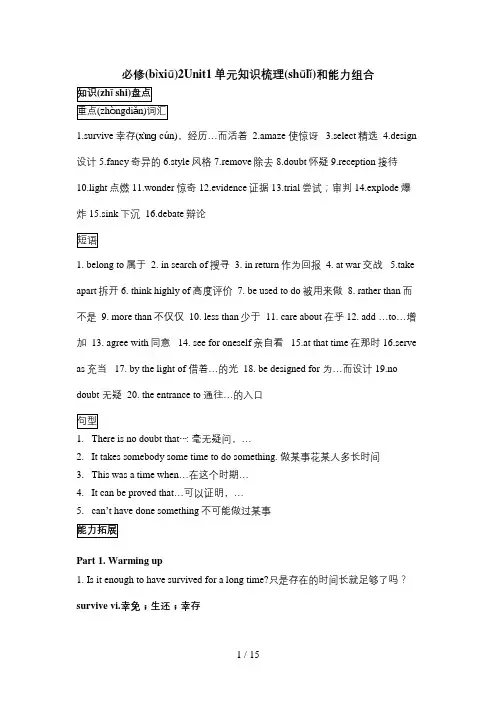
必修(bìxiū)2Unit1单元知识梳理(shūlǐ)和能力组合1.survive幸存(xìnɡ cún),经历…而活着2.amaze 使惊讶3.select精选4.design 设计5.fancy奇异的6.style风格7.remove除去8.doubt怀疑9.reception接待10.light点燃 11.wonder惊奇 12.evidence证据 13.trial尝试;审判 14.explode爆炸 15.sink下沉 16.debate辩论1. belong to属于2. in search of搜寻3. in return作为回报4. at war交战5.take apart拆开6. think highly of高度评价7. be used to do被用来做8. rather than而不是9. more than不仅仅 10. less than少于 11. care about在乎 12. add …to…增加 13. agree with同意 14. see for oneself亲自看 15.at that time在那时 16.serve as充当 17. by the light of 借着…的光 18. be designed for 为…而设计 19.no doubt 无疑 20. the entrance to 通往…的入口1.There is no doubt that…: 毫无疑问,…2.It takes somebody some time to do something. 做某事花某人多长时间3.This was a time when…在这个时期…4.It can be proved that…可以证明,…5.can’t have done something不可能做过某事Part 1. Warming up1. Is it enough to have survived for a long time?只是存在的时间长就足够了吗?survive vi.幸免;生还;幸存vt. 经历……而幸存;比……活的时间长Of the six people injured in the crash, only two survived. 在这次撞车事故受伤的6个人中,只有2个人活了下来。
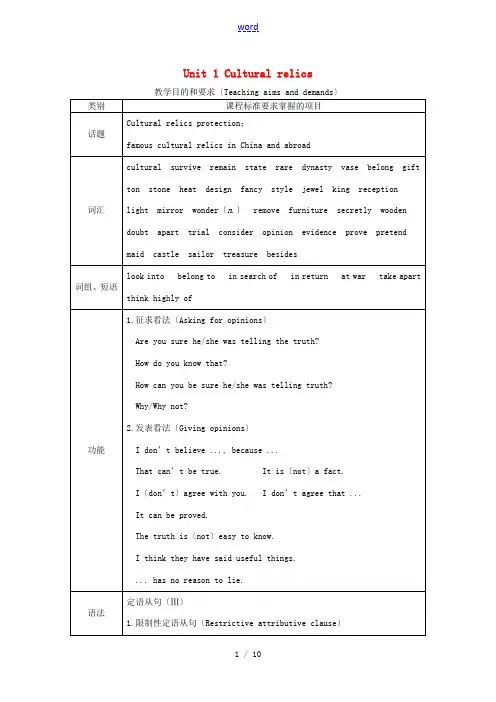
Unit 1 Cultural relics随堂练习1、Fill in the blanks with proper words〔the first letter is given〕The topic of this unit is cultural relics. A cultural relic is something that has survived for a long time, often a part of something that has remained when the rest of it has been destroyed; it tells people about the past.2、Read the passage again and choose the best answer for each blank.①The king of Prussia who gave the Amber Roomas a gift to Russia was B.A Frederick ⅠB Frederick William ⅠC Peter the GreatD Catherine Ⅱ文某某息:Frederick William Ⅰ, the king of Prussia, could never have imagined that his greatest gift to the Russian people would have such a strange history.〔Parag1〕②The king of Prussia gave the Amber Room to Russia because D.A he wanted to marry Catherine ⅡB he was kindC he needed better soldiersD he wanted to make friends文某某息:In 1716, Frederick William Ⅰ, gave it to Peter the Great, as a gift of friendship from the Prussian to the Russian people.〔Parag2〕③The Amber Room was stolen by B.A Russian soldiersB German soldiersC people in KonigsbergD people in St Petersburg文某某息:But some of the Nazis secretly stole the AmberRoom itself.④In 1941, the city of Konigsberg was in A.A GermanyB RussiaC SwedenD France文某某息:But some of the Nazis secretly stole the AmberRoom itself.⑤The Russians didn’t hide the Amber Room because C.A they were at warB they couldn’t find a placeC the German soldiers arrived too soonD no train could take it away文某某息:This was a time when the two countries were at war.3、Look at every statement. If you are “sure〞 it is true, mark “S〞 to the leftof it. If you are “not sure〞, mark “NS〞.〔NS〕1 The Amber Room was not easy to make.〔S〕 2 Catherine Ⅱdidn’t like everything about the Amber Room when she first saw it.〔S〕 3 The Amber Room was taken to Konigsberg and hidden there in 1941.〔NS〕4 The Russians didn’t care about the Amber Room.〔NS〕5 The Russians don’t think the Amber Room will ever be found.课堂笔记1、He insists it belongs to his family.他坚持说这是他家的。
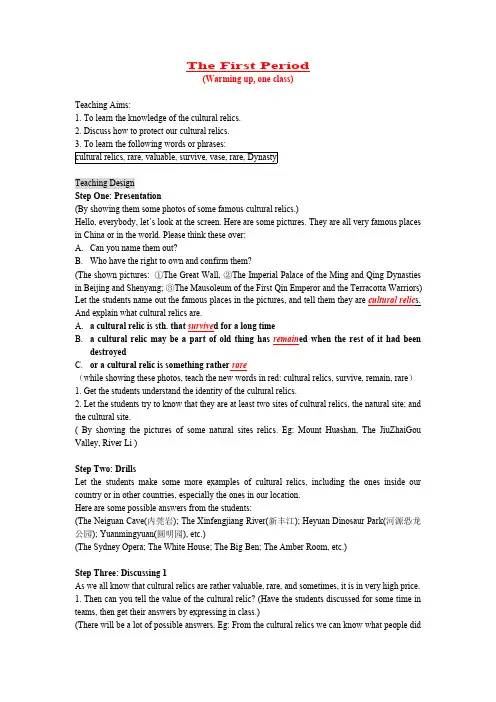
The First Period(Warming up, one class)Teaching Aims:1. To learn the knowledge of the cultural relics.2. Discuss how to protect our cultural relics.3. To learn the following words or phrases:cultural relics, rare, valuable, survive, vase, rare, DynastyTeaching DesignStep One: Presentation(By showing them some photos of some famous cultural relics.)Hello, everybody, let’s look at the screen. Here are some pictures. They are all very famous places in China or in the world. Please think these over:A.Can you name them out?B.Who have the right to own and confirm them?(The shown pictures:①The Great Wall, ②The Imperial Palace of the Ming and Qing Dynasties in Beijing and Shenyang; ③The Mausoleum of the First Qin Emperor and the Terracotta Warriors) Let the students name out the famous places in the pictures, and tell them they are cultural relic s. And explain what cultural relics are.A. a cultural relic is sth. that survive d for a long timeB. a cultural relic may be a part of old thing has remain ed when the rest of it had beendestroyedC.or a cultural relic is something rather rare(while showing these photos, teach the new words in red: cultural relics, survive, remain, rare)1. Get the students understand the identity of the cultural relics.2. Let the students try to know that they are at least two sites of cultural relics, the natural site; and the cultural site.( By showing the pictures of some natural sites relics. Eg: Mount Huashan, The JiuZhaiGou Valley, River Li )Step Two: DrillsLet the students make some more examples of cultural relics, including the ones inside our country or in other countries, especially the ones in our location.Here are some possible answers from the students:(The Neiguan Cave(内莞岩); The Xinfengjiang River(新丰江); Heyuan Dinosaur Park(河源恐龙公园); Yuanmingyuan(圆明园), etc.)(The Sydney Opera; The White House; The Big Ben; The Amber Room, etc.)Step Three: Discussing 1As we all know that cultural relics are rather valuable, rare, and sometimes, it is in very high price.1. Then can you tell the value of the cultural relic? (Have the students discussed for some time in teams, then get their answers by expressing in class.)(There will be a lot of possible answers. Eg: From the cultural relics we can know what people didin the past, and we can know the cultures at that time, and maybe we can know the technology of making them…)2. How to protect the cultural relics? (The same as Question 1)(There will be a lot of possible answers. Eg: Having the idea of protecting our cultural relics; don’t damage them; use them in a right way…..)Step Four: Discussing 21. If you find a cultural relic, what will you do with it?2. Do you think to whom the cultural relics belong?(All cultural relics belong to all people and whole society.)Have the students to discuss the first question for about two or three minutes, then show the answer for their team. Then the same way for Question 2.(While discussing, teach the new phrase in red)The Second Period(Reading part, 2-3 classes)Teaching Aims:1. Reading and understanding, catching the history and information of the Amber Room.2. Functional item, how to tell the story about the Amber Room3. Grammar point: The Attributive Clause4. Learning the following useful words and phrases:in search of, fancy, style, jewel, in return, reception, light, mirror, wonder, at war, remove, furniture, secretly, wooden, doubt, remain, mystery, apart, take apartTeaching DesignStep One: PresentationLast period, we talk about the cultural relics at home and abroad, such as The Great Wall, The Imperial Palace of the Ming and Qing Dynasties in Beijing and Shenyang; The Mausoleum of the First Qin Emperor and the Terracotta Warriors The Sydney Opera; The White House; The Big Ben; The Amber Room (which we have learnt last period)Then, we will go the Amber Room, showing them the pictures of it.Do you know the history of the Amber Room, and do you know where the Amber Room is now? (The Amber Room is a room built by lots of ambers. It was a gift given to Peter the Great, the King of Russia, by the King of Prussia, Frederick William I. It was given the name because almost seven thousand tons of natural ambers were used to make it. But during World WarⅡ in 1941, the Nazi German army secretly stole the Amber Room and sent boxes of the Amber Room on a train to a German City. After that, what really happened to the Amber Room remains a mystery.) Step Two: Reading 1 (Listening, reading and understanding)1. Now please listen to the tape of the text IN SEARCH OF THE AMBER ROOM. And then read aloud. Pay attention to the pronunciation of each word and the pauses within each sentence.2. After reading the text, please complete the exercises of Comprehending.①Keys to Ex1 CEBDAF②The suggested answers to the Ex2Para 1 How was the Amber Room made?Para 2 Why did the King of Prussia give the Amber Room to the Czar of Russia as a gift? Para 3 How did the Amber Room become one of the wonders of the world?Para 4 How did the Amber Room get lost?Para 5 How was a new Amber Room built?3. Detailed ReadingRead the text again and answer the following questions:①.What was given to the Russian people as a great gift by Frederick WilliamⅠ,the Kingof Prussia?(The Amber Room was given to the Russian people as a great gift by Frederick WilliamⅠ,the King of Prussia )②.Why it is called the Amber Room and how many tons of amber were used to make theAmber Room?(Because it was made of seven thousand tons of amber, which has a beautiful yellow brown color)③.What did Catherin eⅡ do with the Amber Room?(She had the Amber Room moved to the palace outside St Petersburg and transformed it.)④. What happen to the Amber Room during World Wa rⅡ?(It was stolen by the Nazi and it was taken apart and missing in World WarⅡ)Step Three: Intensive ReadingSkimming and identifying the general idea of each paragraphNow please read the text again and try to catch the main idea of each paragraph. After about five minutes reading, have some students speak for their teams.1st paragraph: the introduction of the Amber Room(The Amber Room had a strange history and something about its design, color, shape and material.)2nd paragraph: the gift to the Czar(the history of the Amber Room and its use in Russia—the Czar’s winter palace and a small reception hall for important visitors.)3rd paragraph: the relocation of the Amber Room in CatherineⅡ time(CatherineⅡhad the Amber Room moved to the palace outside St Petersburg told the artists to add more details to it.)4th paragraph: the missing of the Amber Room(the German Nazi stole the Amber Room secretly during the World Wa rⅡ,and what really happen to the Amber Room remain a mystery)5th paragraph: the rebuilding of the Amber Room(Russia and Germany have built a new Amber Room for the 300th birthday f St Petersburg.)Step Four: DiscussingClosing down by having a discussionA.Can you imagine the fate of the Amber Room? What is it?B.Do you think if it is worthwhile to reproduce the Amber Room? Why?Have the students discussed one question by one question for some time, and then show theirviews for their teams. There may lots of possible answers.Keys for reference:A: I have no idea about the fate of the Amber Room. Because anything can happen to it. Maybe it was destroyed at war in the fighting fire. You see, ambers can be melted easily. Maybe it was kept secretly by somebody who had died without telling about it to anyone else. So maybe it is lying somewhere quietly.B: I think it is worthwhile to reproduce the Amber Room. Because it represents the culture and a period of history in St Petersburg. It is a trace and feature surviving from a past age and serving to remind people of a lost time.Step Five: New words teachingRead the reading part paragraph by paragraph again and pick up the key words and phrases by themselves, let the students try to explain the meaning and usage.amazing, select, honey, heat, design, fancy, style, decorate, jewel, artist, belong, in return, troop, light(lit), mirror, wonder, at war, remove, furniture, wooden(wood), doubt, formerEspecially pay attention to the words and phrases underlined.Step Six: Grammar points in this textLet the students try to find out the Attributive clause in warming up and the reading part.1. A cultural relic is something that has survived for a long time.2. It is your job to look into any reports of cultural relics that have been found in China.3. You are sent to a small town where you find a relic that was stolen from a palace.4. The man who has it insists that it belongs to his family.5.This gift was the Amber Room, which was given this name because almost seven thousand tons of amber were used to make it.6. Later, CatherineⅡhad the Amber Room moved to the palace outside St Petersburg where she spent her summers.7. In 1770, the room was completed the way she wanted it.8. This was a time when the two countries were at war.Have the student’s judge whether they are the same as those we had learnt before. Especially the 5th one. This will be the homework after class.The Third Period(Learning about Language, 1-2 classes)Teaching Aims:1.To learn some useful words and expressions2.To learn some useful structures3.To learn the Restrictive and Non—Restrictive Attributive ClauseTeaching Important PointLearn how to use the Attributive Clause with that/which/who/where/whenTeaching Difficult Point:⑴. How to tell the Attributive Clause with that/which/who/where/when from other clauses.⑵. Learn the differences between the Restrictive and Non—Restrictive Attributive ClauseTeaching DesignStep One: Retelling (Can be chosen)Retell the story of the Amber Room in their own words.Step Two: Exercising 1 (Exercise 1 &2 on Page 3)(1) Complete Exercise One in Learning about Language on Page3. Asking and answering activity to check the students’ answers of the exercises; individual, pair of group work or finish each task.Here are the keys to Ex1:1.select2.rare3.reception4.amaze5.less than6.wooden7.in search of8.suivive9.remove10.artist11.former12.at war(2) Read the passage and complete it with the words giving.Keys to Ex2:dynasties, style, amazing, jewels, designed, decorated, fancy, rare, doubt, worthStep Three: Exercising 2 (Exercise 3 on Page 3)Look, think and compareRead over the materials in Ex2 carefully and try to find out the different meanings and usages of the phrase belong to,and try to match the meaning with the given sentences.Keys:1.to be the property of; The coat belongs to me.2.to be a part of, be connected with; That top belongs to this desk.3.to be a member of; He belongs to a large family.Step Four: Grammar point (the Attributive clause)1. Discovering useful structures (on Page 4)Let the students try to find out the Attributive clause in warming up and the reading part.1. A cultural relic is something that has survived for a long time.2. It is your job to look into any reports of cultural relics that have been found in China.3. You are sent to a small town where you find a relic that was stolen from a palace.4. The man who has it insists that it belongs to his family.5.This gift was the Amber Room, which was given this name because almost seven thousand tons of amber were used to make it.6. Later, CatherineⅡhad the Amber Room moved to the palace outside St Petersburg where she spent her summers.7. In 1770, the room was completed the way she wanted it.8. This was a time when the two countries were at war.Explain some of them, look at the fifth sentence carefully. Get the students to tell the differences from the others.There is a comma before the relative pronoun which.And this is a Non-Restrictive Attributive clause.The relative clause carries extra information that is not necessary to identify the person or thing being discussed.While the other sentences have the Restrictive Attributive Clauses.●非限制性定语从句的用法:1.非限制性定语从句与先行项的关系不紧密,只是作为附加说明,不起限制作用。
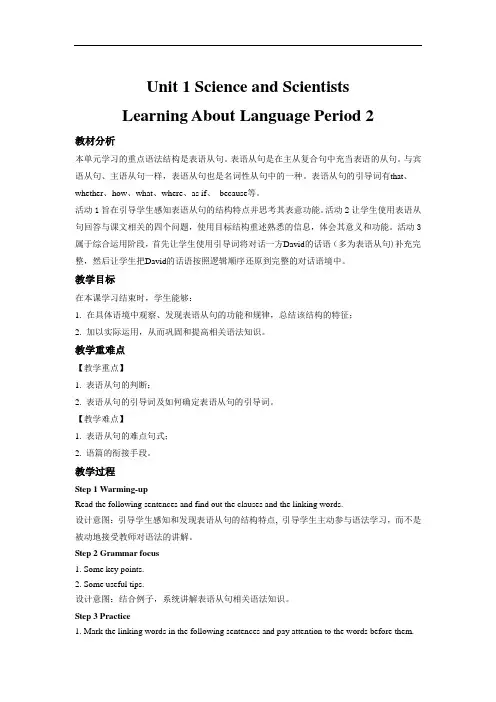
Unit 1 Science and ScientistsLearning About Language Period 2教材分析本单元学习的重点语法结构是表语从句。
表语从句是在主从复合句中充当表语的从句。
与宾语从句、主语从句一样,表语从句也是名词性从句中的一种。
表语从句的引导词有that、whether、how、what、where、as if、because等。
活动1旨在引导学生感知表语从句的结构特点并思考其表意功能。
活动2让学生使用表语从句回答与课文相关的四个问题,使用目标结构重述熟悉的信息,体会其意义和功能。
活动3属于综合运用阶段,首先让学生使用引导词将对话一方David的话语(多为表语从句)补充完整,然后让学生把David的话语按照逻辑顺序还原到完整的对话语境中。
教学目标在本课学习结束时,学生能够:1.在具体语境中观察、发现表语从句的功能和规律,总结该结构的特征;2.加以实际运用,从而巩固和提高相关语法知识。
教学重难点【教学重点】1. 表语从句的判断;2. 表语从句的引导词及如何确定表语从句的引导词。
【教学难点】1. 表语从句的难点句式;2. 语篇的衔接手段。
教学过程Step 1 Warming-upRead the following sentences and find out the clauses and the linking words.设计意图:引导学生感知和发现表语从句的结构特点, 引导学生主动参与语法学习,而不是被动地接受教师对语法的讲解。
Step 2 Grammar focus1. Some key points.2. Some useful tips.设计意图:结合例子,系统讲解表语从句相关语法知识。
Step 3 Practice1. Mark the linking words in the following sentences and pay attention to the words before them.2. Answer the following questions using information from the reading passage as well as the predicative clauses.3. David is talking to Maria about their scientific research project. First complete David’s lines (A-E), using the words in the box. Then put David’s lines in the correct order and practise the conversation.4. What factors help us continue the conversation?5. Complete the conversation and read it.6. Translate the following sentences into English.设计意图:通过不同形式和不同层次的教学活动,引导学生既关注语法结构的形式(form),又关注语法结构的表意功能(meaning),即语法结构在具体语境中的使用,让学生通过完成具体活动掌握单元目标语法结构并发现其规律,运用目标语法结构解决问题。
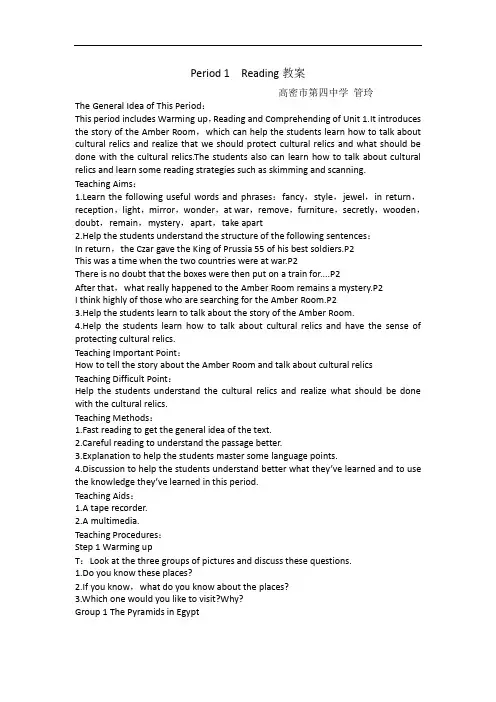
Period 1 Reading教案高密市第四中学管玲The General Idea of This Period:This period includes Warming up,Reading and Comprehending of Unit 1.It introduces the story of the Amber Room,which can help the students learn how to talk about cultural relics and realize that we should protect cultural relics and what should be done with the cultural relics.The students also can learn how to talk about cultural relics and learn some reading strategies such as skimming and scanning.Teaching Aims:1.Learn the following useful words and phrases:fancy,style,jewel,in return,reception,light,mirror,wonder,at war,remove,furniture,secretly,wooden,doubt,remain,mystery,apart,take apart2.Help the students understand the structure of the following sentences:In return,the Czar gave the King of Prussia 55 of his best soldiers.P2This was a time when the two countries were at war.P2There is no doubt that the boxes were then put on a train for....P2After that,what really happened to the Amber Room remains a mystery.P2I think highly of those who are searching for the Amber Room.P23.Help the students learn to talk about the story of the Amber Room.4.Help the students learn how to talk about cultural relics and have the sense of protecting cultural relics.Teaching Important Point:How to tell the story about the Amber Room and talk about cultural relics Teaching Difficult Point:Help the students understand the cultural relics and realize what should be done with the cultural relics.Teaching Methods:1.Fast reading to get the general idea of the text.2.Careful reading to understand the passage better.3.Explanation to help the students master some language points.4.Discussion to help the students understand better what they’ve learned and to use the knowledge they’ve learned in this period.Teaching Aids:1.A tape recorder.2.A multimedia.Teaching Procedures:Step 1 Warming upT:Look at the three groups of pictures and discuss these questions.1.Do you know these places?2.If you know,what do you know about the places?3.Which one would you like to visit?Why?Group 1 The Pyramids in EgyptGroup 2 The Great Wall/ChinaT:Please tell the reasons for their importance.S1:Symbols of their countries.S2:A concrete annotation of their cultures.S3:Have a memorable significance.S4:Bring in money from tourism.The warming-up exercise helps the students realize that there are some well-known cultural relics both at home and abroad.Ask the students to try their best to think of the cultural relics that they know.T:Now,class,look at the title of this unit.Tell me what the topic of this unit is. Ss:The topic of this unit is cultural relics.T:Do you know what cultural relics are?Ss:Cultural relics are something that has survived for a long time,often a part of something old that has remained when the rest of it has been destroyed;it tells people about the past.T:Very good,also we can say:Cultural relics are traces or features surviving from a past age and serving to remind people of them.Just like what you said,they represent the culture of a place and some periods of history.Of course,some of them are in danger because they are being destroyed.Then can you give some examples of the cultural relics that are in the need of being protected?S1:The Great Wall.S2:The Big Ben.Ss:...T:Yes.You are right.Now do you want to know more about these cultural relics? Ss:Yes.Step 2 Pre-readingT:What is your favorite city?Why?What makes a city great?S1:a long historyS2:cultural relicsS3:many great peopleS4:important events taking place thereT:All of you have done a good job.Now let’s come to the text “In Search Of the Amber Room”.Listen to the tape and finish the comprehending exercises.The suggested answers to the comprehending exercise 1:1. D2. C3.A4. A5. D6. C2.The suggested answers to the comprehending exercise 2:TFTF3.The suggested answers to the comprehending Exercise 3:1. 普鲁士国王威廉一世绝不可能想到他送给俄罗斯人民的厚礼会由这样一般令人惊讶的历史。
人教版高中英语必修二Unit1Culturerelics语言点教学案含答案目标认知重点词汇rare, valuable, survive, doubt, remove, amaze, select, design, remain, worth, fancy重点短语belong to, in return, serve as, think highly of, part of重点句型1. … could never have imagined…2. Nor do I think they should give it to any government.知识讲解重点词汇rare【原句回放】Does a cultural relic always have to be rare and valuable? 文化遗产总是稀少而宝贵的吗?【点拨】rare adj. 稀少的, 罕见的It is rare to see a man over 160 years old. 很少见到一个别能活到160岁。
稀薄的The air is rare at high altitudes. 高处空气稀薄。
【拓展】occasional, uncommon, scare, rare均含“稀罕的、很少产生”之意。
occasional 指偶然、间或产生的事,偏重无纪律可循。
uncommon指一般不产生或很少产生的事情,故显得独特、异常与破例。
scare指暂时不易发觉、不存在或数量不足,供不应求的工具。
rare指难得产生的事或难遇见的人或事,偏重特殊性。
valuable【原句回放】Does a cultural relic always have to be rare and valuable? 文化遗产总是稀少而宝贵的吗?【点拨】valuable adj. 很有用的,宝贵的;很值钱的,宝贵的valuable experience 宝贵的阅历valuable jewelry 宝贵的首饰This is one of the most valuable lessons I learned. 这是我所学到的最宝贵的训导。
Unit 1 Science and Scientists Period 2 Learning about Language 教学设计In the aspect of learning strategies, this teaching design focuses on cultivating students' ability to use word formation to induce and memorize vocabulary, and the ability to use lexical chunks to express meaning. Besides, it made some exercise to teach students to match the verbs with the proper prepostions and then instruct them to use the appropriate chunks to complete the sentence in the context appopriately. Other exercise is aimed to guide students to use unit topic words and the sentence patterns in a richer context.1. Guiding the Ss to use unit topic words and the sentence patterns in a richer context.2. Cultivating students' ability to use word formation to induce and memorize vocabulary, and the ability to use lexical chunks to express meaning.1.Instruct students to know more about suffix and prefix.2.Enable students to use the language points in the real situation or specific contexts flexiblyand appropriately.Step1: The teacher instructs the students to build up their vocabulary by reviewing some word-building methods such as prefix and suffix.re:________________________ -ory : ________________________dis: ________________________ -ion : ________________________micro: ________________________ -ial: ________________________trans: ________________________ -ology: ________________________mis: ________________________ -al: ________________________un: ________________________ -or: ________________________multi: ________________________ -ist: ________________________keys:re: retell recycle-ory : theory contradictorydis: disappointdislike -ion :action inventionmicro: Microsoft microphone-ial: beneficial officialtrans: transform transport-ology: biology geologymis: misunderstand misleading-al: natural actualun: Unlike unhappy-or: actorinventor multi: multiple multinational-ist: biologist scientistStep2: Make phrases by combining the words in the left box with those on the right. Then complete the senteces using the proper forms of these phrases.1. Many scientist ____________________the view thatit is human activity that has causedglobal warming.2. He was to________________________the accident because he drove on the wrong side ofthe road.3. The man ________________being behind the robbery was seen crossing the street.4. Since heart disease is often ___________________our lifestyle choice, we need to makehealthy lving an important part of our lives.keys: subscribe to ; blame …for… suspect…of….. link…to….1.subscribed to2. blame for3. suspected of4. linked toStep 3: Fill in the blanks according to the grammar rules.1.I feel it is both of you who are__________ ( blame)for the spoiled child.2. The new student is________sincere that all classmates want to make friends with her.3. ________seemed that the sea lion didn't mind being with the tourists at all.4. Wang Peng sat in his empty restaurant feeling very ________ ( frustrate ) because no customers had come to his restaurant ever since he got up in the morning.5. The way that he did things was________ ( contradiction) to what he had said earlier this week.6.Your________ ( subscribe) will be automatically renewed each month without notice until you cancel it.7. He is coming here___________( pure) because he wants to participate in the football championships again.8. The police suspect him __________having a part in the jewel robbery.9. The vaccine is developed to protect the whole population against _________ (infect )of COVID-19.10. It was reported that Germany had taken a lot of measures to slow the rate of infection, including closing hair and beauty studios. Other non- essential shops __________ ( shut ) already.keys:1.to blame2. so3. It4. frustrated5. contradictory6.subscription7. purely8. of9.infection 10. had been shutStep 4: Complete the sentence according to the Chinese meanings.1. It is not unusual for an athlete to be h_____________(家喻户晓的)name while he is active, and quickly forgotten when his athletic career is over.2. I'm sure she'll h____________(处理) the changes very well because she's very adaptable.3. He was ready to serve dinner to his friends when he realized that he had forgotten to turn on the oven and the meat was _____________(生的) yet.4. He used his s_________________(重大的)influence to change the thinking of the scientific community on this issue.5. Scientists have collected more s________________(数据)than expected to prove the theory. keys:1.household 2.handle 3. raw 4. substantial 5. statisticsStep 5:Read this passage about medical science. Complete it using the words below.infection multiple decrease severetransform proof blame substantialBritish scientists believe they may have found a way to fight the common cold. It blocks a key protein in the body cells that is to __1______________ for the spread of cold-causing virus. Targeting he host rather than __2_______________was a bit non-traditional but made sense because it was tricky to target the virus. Cold-causing virus are not only of 3_____________kinds, they also _4______________ rapidly, meaning they can quickly develop resistance to medicine. Researchers are working on making a form of medicine that can be taken directly into one’s lungs, to5____________ the chance of side effects. Though these scientists have made __6__________________ advances in their research, further___7___________ is needed to make sure such drugs are not so __8____________ that they harm the body.keys:1.blame2.infection3. multiple4.transform5.decrease6.substantial7. proof8.severeStep 6: Dictate the key words and phrases in this unit.Part 1: key words:1. proof n.证据;证明;检验2. multiple adj.数量多的;多种多样的3. household n.一家人;家庭;同住一所(套)房子的人4. suspect vt.&vi.怀疑;疑有;不信任n.犯罪嫌疑人;可疑对象5. blame vt.把……归咎于;责怪;指责n. 责备;指责6. handle n.把手;拉手;柄vt. 处理;搬动;操纵(车辆、动物、工具等)7. intervention n.介入;出面;干涉8. link vt.把……连接起来;相关联n. 联系;纽带9. raw adj.未煮的;生的;未经处理的;原始的10. pure adj.干净的;纯的;纯粹的11. substantial adj.大量的;价值巨大的;重大的12. decrease n.减少;降低;减少量vt.&vi. (使大小、数量等)减少;减小;13. statistic n.[pl.]统计数字;统计资料;统计学14. transform vt.使改观;使改变形态vi.改变;转变15. thinking n.思想;思维;见解16. finding n. 发现;调查结果;(法律)判决17. initial adj. 最初的;开始的;第一的18. solid adj. 可靠的;固体的;坚实的n. 固体Part 2:Key phrases1.once and for all 最终地;彻底地2.subscribe to 同意;赞同3.thanks to 幸亏;由于4.attend to 照料;照顾5.think of 想起;考虑6.as a result of 由于……的结果7.in general 总之;通常;一般而言8.find out 找出;查明9.what's more 而且;另外Step 7: complete the discourse according to the grammar rules.Cholera used to be one of the most 1.__________ (fear) diseases in the world. In the early 19th century, _2_________ an outbreak of cholera hit Europe, millions of people died. But neither its cause, 3__________ its cure was understood. A British doctor, John Snow, wanted to solve the problem and he knew that cholera would not be controlled _4_________ its cause was found. In general, there were two contradictory theories 5 __________ explained how cholera spread. The first suggested that bad air caused the disease. The second was that cholera was caused by an _6_________(infect) from germs in food or water. John Snow thought that the second theory was correct but he needed proof. So when another outbreak of cholera hit London in 1854, he began to investigate. Later, with all the evidence he _7_________ (gather), John Snow was able to announce that the pump water carried cholera germs. Therefore, he had the handle of the pump _8_________ (remove) so that it couldn't be used. Through his intervention,the disease was stopped in its tracks. What is more, John Snow found that some companies sold water from the River Thames that __9__________________ (pollute) by raw waste. The people who drank this water were much more likely _10_________ (get) cholera than those who drank pure or boiled water. Through John Snow's efforts, the _11_________ (threaten) of cholera around the world saw a substantial increase.Keys:1.feared 2.when 3. nor 4.unless 5.that/which 6.infection 7.had gathered 8.removed 9.was polluted 10.to get 11. threat。
Unit 1 Science and ScientistsUsing Language Period 2教材分析本节有两个阅读语篇,分别是关于钱学森和史蒂芬霍金的人物传记,它们从不同的角度简要叙述了两位科学家的经历、重要贡献、性格特点以及他们所具备的科学素养。
在写作策略和技巧上,两个文本都有效使用了一些衔接词语,实现了语篇的衔接和连贯。
通过要求学生阅读这两篇人物传记,分析伟大科学家所具备的素养和品质,了解人物传记语篇的结构并关注语篇的衔接和连贯,在此基础上结合自身体验和知识积累完成一篇有关科学精神的写作任务,阐述科学精神的内涵。
教学目标在本课学习结束时,学生能够:1. 梳理人物传记的语篇结构和文本逻辑;2.正确识别文章中的衔接词语;3. 了解科学家所具备的品格和素养,深入理解和体会科学精神的内涵,并阐述自己对科学精神的理解和感悟。
教学重难点【教学重点】1. 掌握人物传记类文章的文体结构、行文特点和语言特色;2. 掌握文本中出现的衔接词语,培养使用衔接词语的意识和能力;3. 分析科学家身上所体现的科学精神,正确理解他们的品格和素养。
【教学难点】能结合具体的事例阐述自己对科学精神内涵的理解,并根据所总结的语篇结构在写作中恰当使用衔接词语,做到衔接自然、行文流畅。
教学过程Step 1 Warming-upDiscuss the following questions.1) Could you name the scientists you know?2) Can you recognize them?设计意图:引出话题,引导学生将已有的知识体系与本课将要学习的内容联系起来,并为本课将要学习的语篇做好铺垫。
Step 2 Reading1.Read the texts quickly and decide if the statements are true (T) or false (F).设计意图:引导学生关注文章细节,了解两位科学家的经历和事迹。
高中英语新人教版必修二-Unit-1--词汇拓展必修二Unit 1词汇拓展1、creative adj 创造性的,有创造力的,有创意的in a creative way 创造性地;create vt 创造,创作;creation n 创造,作品;creatively adv 创造性地,有创造力地;creativity n 创造性,创造力2、 former adj 以前的; (两者中)前者的; n前者the former … the latter …前者…后者3、 preserve vt n( 1 ) preserve…from/against ( doing) sth.保护....免受…preserve sth. for..为 .....而保存某事物preserve endangered species from extinction保护濒危物种不致灭绝preserve these traditional customs保留这些传统习俗be well preserved保存完好in the preserve在保护区内nature preserve自然保护区(2) preservation n. 维护;保护;保持;保养4、 promote vt 促进、提升、推销、晋级promote sb to …提升某人为…be p romoted to …被提升为…promote sb. from …to ....将某人从...升职到…get promoted升职(2) promotion n.提升;提拔;促销活动5、application n 申请(表)、用途、运用、应用(程序)app n.应用程序;应用软件(application的缩略形式) make an application (to sb.) for sth.(向某人)申请...... hundreds of jobapplications数百封求职信fill in an application form填写申请表apply v.应用;申请apply…to...把....应用到....apply oneself to致力于,专心于apply (to sb.) for... (向某人)申请.....applicant n.申请人6、take part in 参与某事;参加某活动;take part参加(无宾语时,不用in)take an active part in积极参加(当part前有形容词修饰时,形容词前要加不定冠词) play a part in在....中起作用; 在.....中扮演角色play an important part in在...起重要作用;.....中扮演重要角色◆词语辨析take part in:参加群众性活动,并发挥一定的作用join in:参加正在进行的活动,常可与take part in换用join:加入某团体或组织,成为其中的一员,也可指加入某人的行列attend :参加会议、婚礼、葬礼、典礼或上课、上学等7、give way to 让步、屈服give in让步,屈服,投降;呈交,交上give in to.... 向......屈服give up doing sth.放弃做某事give away泄露;赠送,分发give back归还;使恢复give out用完,耗尽;分发,散发give off发出,放出(光、热、气味等)8、balance n 平衡;均匀 vt 使平衡keep (one') balance保持平衡lose (one's) balance失去平衡keep a balance between A and B 保持A与B之间的平衡the balance of nature 自然界的平衡balanced adj 平衡的,均衡的a balanced diet均衡饮食9、lead to 导致、造成后果;通向;前往lead to the traffic accident导致这场交通事故lead to health problem引起健康问题lead to the top of the hill通往山顶导致,引起”的多种表达: result in; bringabout ; contribute to10、in order to 为了;以便(表示目的)in order to;so as to为了,以便(表示目的)动词不定式的一个主要作用,是在句中作目的状语。
2019新人教高中英语选择性必修二Unit 1 Discover Useful Structures 公开课教案Teaching aims:By the end of the period, students will be able to:1.To analyse the forms and features of predicative clauses.2.To learn about the functions of predicative clauses in the context.3.To use predicative clauses in the given context.Teaching key and difficult points:1.Help students to analyse and use predicative clauses.2.Instruct students to use predicative clauses to express their own ideas.Teaching procedures:StepⅠLead-inIn those days,there were two contradictory theories to explain how cholera spread.One theory was that bad air caused the disease.Another was that cholera was caused by an infection from germs in food or water.Snow subscribed to the second theory.One evidence is that a woman and her daughter had died of cholera after moving away from Broad Street.It seemed that she liked the water from the pump so much that she had it delivered to her house every day.The truth was that the water from the Broad Street pump had been infected by waste.1.Can you find any predicative clauses?2.Why do you think they are predicative clauses?3.What are the main linking verbs?Suggested answers:1.In those days,there were two contradictory theories to explain how cholera spread.One theory was that bad air caused the disease.Another was that cholera was caused by an infection from germs in food or water. Snow subscribed to the second theory.One evidence is that a woman and her daughter had died of cholera after moving away from Broad Street.It seemed that she liked the water from the pump so much that she had it delivered to her house every day.The truth was that the waterfrom the Broad Street pump had been infected by waste.2.Because there are linking verbs closely before the predicative sentences.3.Linking verbs{状态类:be,seem,appear,keep,remain, stay...感官类:look,smell,taste,sound,feel...变化类:become,get,turn,grow,fall, come,go...StepⅠObserve and analyseActivity 1Ask and answer the questions in pairs using the information from the reading passage.(P5 Activity 2)(红色部分为学生作答)1.What was Snow’s discovery in two particular streets in London?Snow’s discovery in two particular streets in London was that the cholera outbreak was so severe that more than 500 people died in ten days.2.What was Snow determined to find out during the 1854 outbreak of cholera in London?What Snow was determined to find out was why so many people died/the outbreak of cholera had caused over 500 deaths within ten days.3.What were the exact places Snow marked on the map?The exact places Snow marked on the map were where all those who died had lived/ all the dead people had lived.4.What was the finding that Snow announced?Snow’s finding was that the pump water carried cholera germs/ the water pump was to blame for the spread of cholera.Activity 2Fill in the blanks.1.Snow’s discovery in two particular streets in London was that the cholera outbreak was so severe that more than 500 people died in ten days.2.What Snow was determined to find out was why so many people died.3.The exact places Snow marked on the map were where all those who died had lived.4.Snow’s finding was that the pump water carried cholera germs.Activity 3Fill in the form.引导词that which whether w hat who As if/asthoughwhy when where how作的成分不作成分定语表语不作成分主语宾语表语定语主语宾语表语不作成分状语状语状语状语意思无意思哪一个是否什么谁好像为什么什么时候在哪里如何;怎样Step Ⅰ PracticeActivity 1Complete David’s lines(A~E) by filling in guiding words.(P5 Activity 3) as if that what who when how why whosewhich whetherA.Absolutely.You may not believe it,but that was happened at the initial stage of our group’s research on developing a vaccine for malaria.B.Yes,it is.And it seemed all the theories were useful,but the fact was we couldn’t persuade one another that one theory was better than another.C.Exactly.The problem was not about all our theories were equally good,but in deciding theory to depend upon.D.We realized that what we cared about was not aspect we needed to develop a theory in,but rather we can reduce the cost of a vaccine without reducing its effect!E.You’re right.At last,we became focused on the key issue,which was we had to carry out the research in the first place.Suggested answers:A:what B:as if;that C:whether;whose/which/what D:which/what;how E:whyActivity 2Put A~E in the correct order using the above methods.Then check the answers and state the reasons.(P5 Activity 3)A.Absolutely.You may not believe it,but that was what happened at the initial stage of our group’s research on developing a vaccine for malaria.B.Yes,it is.And it seemed as if all the theories were useful,but the fact was that we couldn’t persuade one another that one theory was better than another.C.Exactly.The problem was not about whether all our theories were equally good,but in deciding whose theory to depend upon.D.We realized that what we cared about was not which aspect we needed to develop a theory in,but rather how we can reduce the cost of a vaccine without reducing its effect!E.You’re right.At last,we became focused on the key issue,which was why we had to carry out the research in the first place.Maria:This mix of theory and data is one of the key characteristics of what we call science.David:______________________________Reason:______________________________Maria:With your theoretical framework?David:________________________________Reason:__________________________________Maria:Deciding on a theory is definitely of critical importance.David:_____________________________________Reason:____________________________________Maria:This was when you should have calmed down and got down to doing some solid work.David:__________________________________________Reason:_________________________________________Maria:So what happened in the end?David:__________________________________________Reason:________________________________________Suggested answers:A(Logical connector)C(Lexical connector) B(Grammatical connector) E(Logical connector) D(Grammatical connector)Activity 3Answer the following questions about the dialogue using the predicative clauses.1.What was David’s group’s research?2.What was the problem?3.What was the key issue?4.What did they care about?Suggested answers:1.David’s group’s research was that they wanted to develop a vaccine for malaria.2.The problem was that they had to decide which theory to depend upon.3.The key issue was why they had to carry out the research in the first place.4.What they cared about was how they could reduce the cost of a vaccine without reducing its effect.StepⅠ Language use and shareActivity 1Work in plete the conversations using the predicative clauses.Every group can choose one or two dialogues,and each member must complete at least two predicative clauses.1.A:Paper making,printing,gunpowder,and the compass are the four great inventions of ancient China.They are significant contributions of the Chinese nation to the world.B:Sure,they are.What I want to know though is .2.A:The ancient Chinese were the first to invent paper and printing.Then they went on to invent books and had opened bookshops in many cities.B:What I’m curious about is .3.A:The compass is a special invention of ancient China,dating back to as early as the Warring States Period.B:Yes.It seems .4.A:Gunpowder was originally used for making fireworks.B:But what surprises me is .5.A:High-speed trains,mobile payments,the bike-sharing system,and online shopping are considered by some as the new “four inventions” of China.B:Is that so? I feel/It seems .Suggested answers:1.which one is the greatest invention/how these inventions have changed China and the world2.who invented paper/how people made the first paper/when ink was invented/what paper was made from/when and how printing spread to the rest of the world/how records were kept before the invention of paper3.that the compass was particularly useful/as if people had to depend on the positions of the sun,the moon,and so on when they were at sea before the compass was invented/that ancient Chinese had developed a good knowledge of magnetism4.that gunpowder was not used initially for firearms/how it is so unexpectedly used today/how heavily mining depends upon it/that it has been generally used not only in industries but in wars across the world5.that these inventions have really made our lives easier/that every Chinese is proud of the new “four inventions”/as if I could not live without them,especially when it comes to online shopping/that we all benefit from all these things/that we may have to remember that every coin has two sidesStepⅠconsolidationⅠ.Fill in the blanks with guiding words.1.Look at the tallest building.That is my father works.2.One of the most exciting moments in my life was I won first place in the singing competition.3.Now,the only problem is we can collect enough money for the project.4.One advantage of solar energy is it will never run out.5.What is troubling me is I don’t have much experience of this kindof work.6.That’s you are wrong.You forgot Step Three.Ⅰ.Choose the best answer.1.Without his support,we couldn’t be we are now.A.howB.whenC.whereD.why2.This is my father has taught me—to always face difficulties and hope for the best.A.howB.whichC.thatD.what3.By boat is the only way to get here,which is we arrived.A.whereB.whenC.whyD.howSuggested answers:Ⅰ 1.where 2.when 3.whether/how/when 4.that 5.that 6.where/whyⅠ 1.C 2.D 3.D。